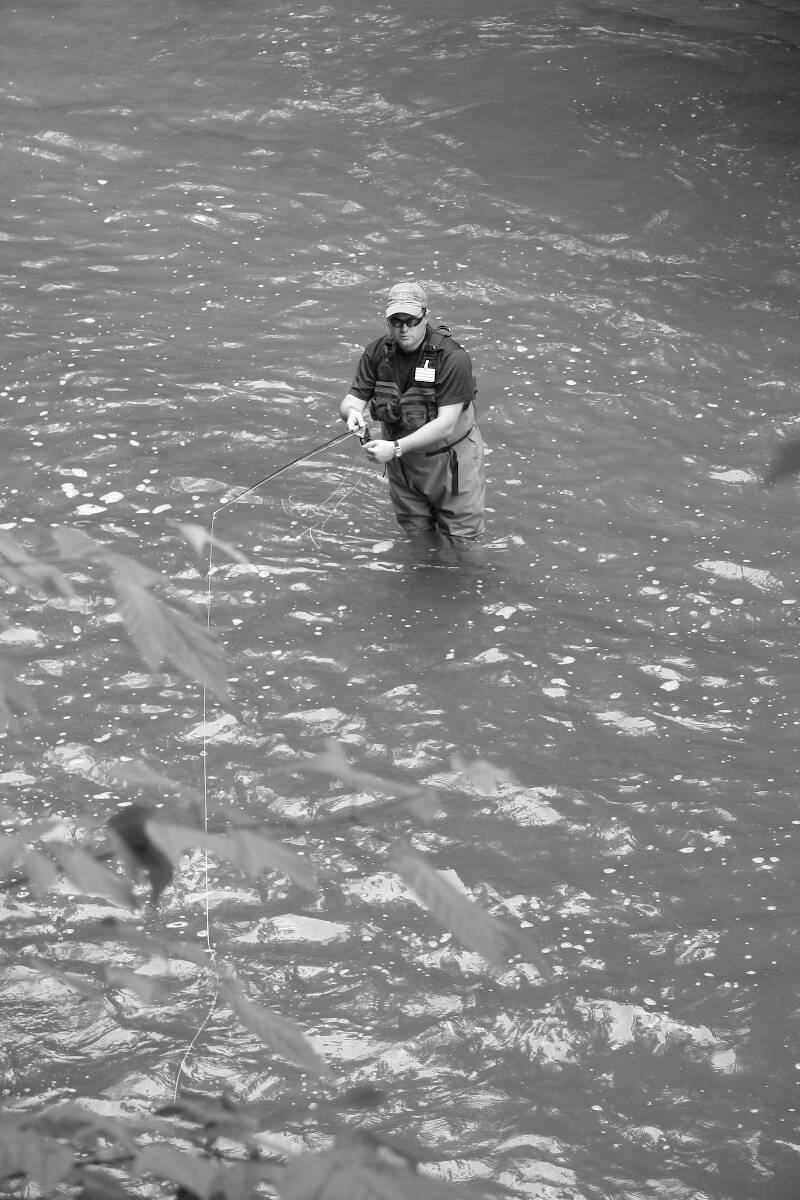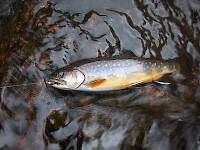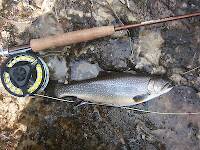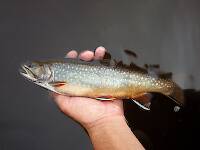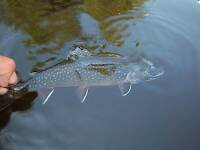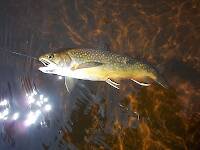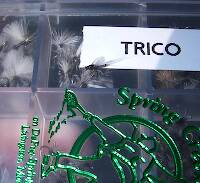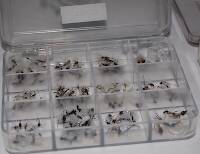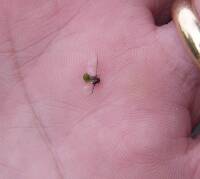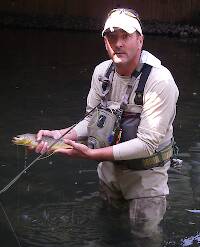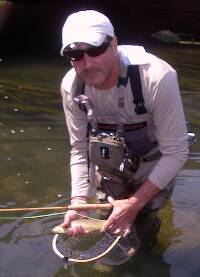
Salmonflies
Pteronarcys californica
The giant Salmonflies of the Western mountains are legendary for their proclivity to elicit consistent dry-fly action and ferocious strikes.
Featured on the forum

This is the first of it's family I've seen, collected from a tiny, fishless stream in the Cascades. The three species of this genus all live in the Northwest and are predators that primarily eat stonefly nymphs Merritt R.W., Cummins, K.W., and Berg, M.B. (2019).

Troutnut is a project started in 2003 by salmonid ecologist Jason "Troutnut" Neuswanger to help anglers and
fly tyers unabashedly embrace the entomological side of the sport. Learn more about Troutnut or
support the project for an enhanced experience here.
Martinlf on Mar 28, 2007March 28th, 2007, 12:21 pm EDT
Softhackle's thread on fishing subsurface held my attention, and reconfirmed my determination to use wet flies more often. But recently it's nymphing that has me most baffled. Several months ago I fished a spring creek about an hour's drive away and with the water a bit up and the air temps in the 50's in a short space of time I caught about 6 fish on a big Walt's Worm, my go-to fly for high water, and lost what I think was a pretty nice fish in one specific hole. A return trip about a month later with a partner found the water lower, probably colder, and the fish tougher. We fished a lot more water, but between the two of us we landed only four fish on scuds and a smaller Walt's Worm, and found no action in several holes that had held fish before. I came back a week or so ago and with low clear water hit the hole that I'd lost the bigger fish in again, using a green weenie this time. He hit it, somewhat to my surprise, but it was on again, off again. Grrr. (I'd had another, smaller fish come unbuttoned as well, just before--OK Taxon, I'm obviously not there yet.) Two days ago I returned to find the water up and off color, as the first day. I was delighted, and thought that at least I'd get a good look at the mystery fish, or some of his brothers, but the fishing turned out to be very tough. Finally, with a size 14 ugly ball of a muskrat nymph, I found a few fish in holes that had seemed empty previously, but in the holes that had held fish before, nothing, nada, zip. This was especially irritating in the "big fish hole" that had given up at least one fish every other time I had fished it. by the way, that last day, the big Walt's Worm, which I started out with, wasn't working at all. Or would it have later (when I had switched to the muskrat) if I'd just left it on?
OK, OK, I know there are too many variables here, but my frustration stems from my complete inability to understand why one day fish are all over a nymph that many consider a very good general bet, then another day they won't touch it under seemingly identical, or even better conditions. The last day the water temperature should have been ideal to get fish to feed, unlike the colder water earlier in the season. I begin to wonder, "Are the fish just more gullible early season, and my amateur nymphing works then, but when they become more experienced my technique brings giggles rather than a bite?" With dry flies and rising fish I can see drag, and if there's none, can change the fly or move to get a better angle or slightly different drift. But when nymphing blind it seems so much like a guessing game if things aren't working. More weight? Less weight? Weight closer to fly? Weight farther from fly? New fly? Lighter tippet? Loop knot? The questions seem endless, and on a tough day I end up with very little confidence in my skills or ability to answer the questions knowledgeably. I've always heard you need to present the nymph on the bottom most of the time, and that an indicator that moves a bit slower than the current is a good sign that one is in the zone. So far this has been at least one constant that I felt I could count on, but maybe not.
Now I'm not really complaining. It's been a good year so far in general, mostly on dry flies, but this stream and nymphing have made for a puzzling combination, especially recently.
Any ideas, pity, etc. will be welcome.
OK, OK, I know there are too many variables here, but my frustration stems from my complete inability to understand why one day fish are all over a nymph that many consider a very good general bet, then another day they won't touch it under seemingly identical, or even better conditions. The last day the water temperature should have been ideal to get fish to feed, unlike the colder water earlier in the season. I begin to wonder, "Are the fish just more gullible early season, and my amateur nymphing works then, but when they become more experienced my technique brings giggles rather than a bite?" With dry flies and rising fish I can see drag, and if there's none, can change the fly or move to get a better angle or slightly different drift. But when nymphing blind it seems so much like a guessing game if things aren't working. More weight? Less weight? Weight closer to fly? Weight farther from fly? New fly? Lighter tippet? Loop knot? The questions seem endless, and on a tough day I end up with very little confidence in my skills or ability to answer the questions knowledgeably. I've always heard you need to present the nymph on the bottom most of the time, and that an indicator that moves a bit slower than the current is a good sign that one is in the zone. So far this has been at least one constant that I felt I could count on, but maybe not.
Now I'm not really complaining. It's been a good year so far in general, mostly on dry flies, but this stream and nymphing have made for a puzzling combination, especially recently.
Any ideas, pity, etc. will be welcome.
"He spread them a yard and a half. 'And every one that got away is this big.'"
--Fred Chappell
--Fred Chappell
JAD on Mar 28, 2007March 28th, 2007, 2:45 pm EDT
Louis
Old buddy--- knock me over with a feather.
(OK, OK, I know there are too many variables here, but my frustration stems from my complete inability to understand why one day fish are all over a nymph that many consider a very good general bet, then another day they won't touch it under seemingly identical, or even better conditions)
Thats called fishing :) relax have a beer.
Lloyd said it about six months ago ,you need all the facts to draw a conclusion. How do you know someone didn't put the big hurt on those fish a couple days before you tried. Louis I'm sure you know how to float a nymph over those fish, some days they just don't open their mouths.
If their is ever any thing I can do let me know, Ill be at the camp-ground most of the summer stop in .
John
They fasten red (crimson red) wool around a hook, and fix onto the wool two feathers which grow under a cock’s wattles, and which in colour are like wax.
Radcliffe's Fishing from the Earliest Times,
Martinlf on Mar 28, 2007March 28th, 2007, 11:58 pm EDT
Hey John,
Thanks for the words. Like you said, it's called fishing, not catching for a reason. Taxon once said there are two kinds of fishing days, great when you catch fish, and great when you don't. He was probably saying just enjoy being out there, and that last day described above I did pick up a beautiful rainbow from a run where I've never caught a fish before, so that should be enough. I just really want a good look at that fish that keeps getting off, and thought I'd surely get a good look at him with the cloudy water and higher temps. I'll have a beer, be thankful for those good days with the olives, and you can bet that I'll drop by your place on the J this season.
Thanks for the words. Like you said, it's called fishing, not catching for a reason. Taxon once said there are two kinds of fishing days, great when you catch fish, and great when you don't. He was probably saying just enjoy being out there, and that last day described above I did pick up a beautiful rainbow from a run where I've never caught a fish before, so that should be enough. I just really want a good look at that fish that keeps getting off, and thought I'd surely get a good look at him with the cloudy water and higher temps. I'll have a beer, be thankful for those good days with the olives, and you can bet that I'll drop by your place on the J this season.
"He spread them a yard and a half. 'And every one that got away is this big.'"
--Fred Chappell
--Fred Chappell
GONZO on Mar 29, 2007March 29th, 2007, 8:09 am EDT
Louis-
You are far too good a fisherman for me to pity you, but I will share an idea or two.
John's exactly right. Sometimes we fail to consider how recent fishing pressure factors into our daily success or lack thereof. Imagine your best day on a favorite stream. Now imagine the fate of the next poor fellow that follows you on that water. Don't you think he might experience something very similar to what you describe? And it's not like our own success should make us expect that the fishing will be just as easy the next time around--pressure is cumulative, whether we create it or someone else does.
Variables--that's the key word. I think that you are grappling with the basic nature of blind nymphing. It's easy to fall into the trap of comparing "nymphing the water" to "fishing the rise" with a dry fly.
When we present a dry to rising fish, many of the variables are removed from the equation. We know the location of the fish. We know it is feeding (at least occasionally) on or near the surface. We often know (or can figure out) what it is eating. And when we present the fly, we can easily evaluate our accuracy and drift. Even when the fish ignores or rejects the fly, it suggests some obvious possibilities about why that may have happened.
But blind nymphing provides no such advantages. Even when we think we have some idea about location, depth, and food, it is hard to be sure. Evaluating accuracy and drift often involves intuition and feel rather than something we can observe directly. (The movement of an indicator is merely a vague and general reference that we can only read consistently in consistent situations.) And determining when fish might be ignoring or rejecting the fly is almost entirely reduced to educated guesswork.
Another negative carryover from dry-fly fishing is the tendency to assume that if five casts to a given spot or drift adequately cover the water (meaning that the fish probably saw the fly) then the same is true for the nymph. But that is not the case except in the very simplest of drifts in very shallow water. Sight-nymphing to fish visibly holding in deep complicated drifts will demonstrate that putting the nymph in front of the fish is a much trickier task than running a dry over that same fish. It may take many times the casts and many variations on that cast before the fly is properly shown to the fish. And with each cast and each variation one runs the risk of letting the fish see the fly in a bad way before it sees it in a good way. Nymphing can be wickedly effective, but, except in certain spots at certain times, it ain't easy!
Finally, my friend, you may simply be expecting to achieve a level of consistency that just isn't possible in some streams. One of my all-time favorite streams is incredibly fickle. I probably know it about as well as anyone alive, but I still wouldn't wager much on my ability to produce a number of fish on any given day. It is gloriously generous at times, and on other (often similar) days it is stingy as hell. These day-to-day differences aren't entirely random, but they aren't entirely controllable either. And some days I just fish BADLY. I have some statistics gleaned from many decades of notes (that I'll share with you privately) that might shed some light on this.
Louis, many fly fishers can only hope to fish as well as you do. Continue to grapple with the variables by all means, but find some small contentment in that. :)
Best,
Lloyd
Any ideas, pity, etc. will be welcome.
You are far too good a fisherman for me to pity you, but I will share an idea or two.
How do you know that someone didn't put the big hurt on those fish a couple days before you tried
John's exactly right. Sometimes we fail to consider how recent fishing pressure factors into our daily success or lack thereof. Imagine your best day on a favorite stream. Now imagine the fate of the next poor fellow that follows you on that water. Don't you think he might experience something very similar to what you describe? And it's not like our own success should make us expect that the fishing will be just as easy the next time around--pressure is cumulative, whether we create it or someone else does.
OK, OK, I know there are too many variables here....
Variables--that's the key word. I think that you are grappling with the basic nature of blind nymphing. It's easy to fall into the trap of comparing "nymphing the water" to "fishing the rise" with a dry fly.
When we present a dry to rising fish, many of the variables are removed from the equation. We know the location of the fish. We know it is feeding (at least occasionally) on or near the surface. We often know (or can figure out) what it is eating. And when we present the fly, we can easily evaluate our accuracy and drift. Even when the fish ignores or rejects the fly, it suggests some obvious possibilities about why that may have happened.
But blind nymphing provides no such advantages. Even when we think we have some idea about location, depth, and food, it is hard to be sure. Evaluating accuracy and drift often involves intuition and feel rather than something we can observe directly. (The movement of an indicator is merely a vague and general reference that we can only read consistently in consistent situations.) And determining when fish might be ignoring or rejecting the fly is almost entirely reduced to educated guesswork.
Another negative carryover from dry-fly fishing is the tendency to assume that if five casts to a given spot or drift adequately cover the water (meaning that the fish probably saw the fly) then the same is true for the nymph. But that is not the case except in the very simplest of drifts in very shallow water. Sight-nymphing to fish visibly holding in deep complicated drifts will demonstrate that putting the nymph in front of the fish is a much trickier task than running a dry over that same fish. It may take many times the casts and many variations on that cast before the fly is properly shown to the fish. And with each cast and each variation one runs the risk of letting the fish see the fly in a bad way before it sees it in a good way. Nymphing can be wickedly effective, but, except in certain spots at certain times, it ain't easy!
Finally, my friend, you may simply be expecting to achieve a level of consistency that just isn't possible in some streams. One of my all-time favorite streams is incredibly fickle. I probably know it about as well as anyone alive, but I still wouldn't wager much on my ability to produce a number of fish on any given day. It is gloriously generous at times, and on other (often similar) days it is stingy as hell. These day-to-day differences aren't entirely random, but they aren't entirely controllable either. And some days I just fish BADLY. I have some statistics gleaned from many decades of notes (that I'll share with you privately) that might shed some light on this.
Louis, many fly fishers can only hope to fish as well as you do. Continue to grapple with the variables by all means, but find some small contentment in that. :)
Best,
Lloyd
Martinlf on Mar 29, 2007March 29th, 2007, 12:45 pm EDT
Thanks again, guys. The points about fish with sore mouths and fickle streams are both very helpful. Before this year I had only fished the stream in question once or twice a year, and had always had pretty good luck. This year I visited it repeatedly, trying to get that one fish landed, or at least close enough to speculate about its size. In past years I rarely saw anyone fishing, but this year I've seen fishermen most of the times I've been there. So it seems to be getting more pressure. I also realize my expectations simply weren't realistic, and that's the key for me. As Taxon suggested before, it's about enjoying the stream, and not about having expectations so high that you miss out on the fun of being on the water and learning. Oh, by the way, I spent this afternoon on a different stream, one I consider very tough in general, in bright sunlight and with very clear water, and did the best in terms of numbers I've ever done there. So, I'm back. One other note--every fish today took Gonzo's scud pattern. It's a keeper.
"He spread them a yard and a half. 'And every one that got away is this big.'"
--Fred Chappell
--Fred Chappell
Troutnut on Mar 29, 2007March 29th, 2007, 4:14 pm EDT
Another negative carryover from dry-fly fishing is the tendency to assume that if five casts to a given spot or drift adequately cover the water (meaning that the fish probably saw the fly) then the same is true for the nymph. But that is not the case except in the very simplest of drifts in very shallow water. Sight-nymphing to fish visibly holding in deep complicated drifts will demonstrate that putting the nymph in front of the fish is a much trickier task than running a dry over that same fish. It may take many times the casts and many variations on that cast before the fly is properly shown to the fish.
That's a really good point, and it's one of the first lessons the Namekagon taught me about nymphing. In that river, it seems the fish rarely move very far to intercept food, partially because the tannin-stained water reduces visibility and partially because there's so much food they can afford to be lazy. So there's really a narrow area your fly must enter to have a chance of being taken.
On top of all the complications Gonzo mentioned, keep in mind that (as with dries) your cast may need to be timed with the fish's feeding rhythm. Unless you see the fish you can't time your cast, so there's a little extra element of blind luck involved.
I did a lot of fishing in the Namekagon in March a few seasons back, and I learned the value of making 50-100 seemingly identical casts in certain spots. I caught most of my best fish after 20+ casts.
Jason Neuswanger, Ph.D.
Troutnut and salmonid ecologist
Troutnut and salmonid ecologist
JAD on Mar 30, 2007March 30th, 2007, 3:00 am EDT
Hi Louis
(I'm back. One other note--every fish today took Gonzo's scud pattern. It's a keeper.)
First part --We knew that.
Second part------- O one of little faith----- was that issue ever in dispute.
Louis you have pm
John
(I'm back. One other note--every fish today took Gonzo's scud pattern. It's a keeper.)
First part --We knew that.
Second part------- O one of little faith----- was that issue ever in dispute.
Louis you have pm
John
They fasten red (crimson red) wool around a hook, and fix onto the wool two feathers which grow under a cock’s wattles, and which in colour are like wax.
Radcliffe's Fishing from the Earliest Times,
Martinlf on Apr 16, 2009April 16th, 2009, 2:10 am EDT
I'm bumping this back up because there's much nymphing wisdom here as well. Thanks, Gonzo, for the reminder about the deja vu experience. I see the time of year was about the same.
One of my favorite comments is John's "relax, have a beer."
One of my favorite comments is John's "relax, have a beer."
"He spread them a yard and a half. 'And every one that got away is this big.'"
--Fred Chappell
--Fred Chappell
Hellgramite on Apr 16, 2009April 16th, 2009, 4:59 am EDT
Trout are like women they have no idea what there going to do at any one point in time.
Hellgramite on Apr 16, 2009April 16th, 2009, 11:18 am EDT
Fishing of all kinds what ever it be ocean,lake,stream,river what ever.All we can do as humans is look back at history.What do we know?We know that in spring Insects hatch,the water has warmed up and the fish are more active and feeding more.We also know that in the summer the water gets warmer the Insects hatch more often and the fish move into the deeper pools because the water is cooler.We know in the winter the Insects stop hatching and the main food for fish are nymphs.In fact nymphs are 90% of a Trouts diet.My point is is that when we try to predict what a Trout is going to eat at a time of day,week,or even hour is so unpredictable.All we can do is put all the information we know together and try to catch fish.Some days we get it and some days we don't.There is only one thing I can guarantee and that is I will never stop trying to get it.
JAD on Apr 16, 2009April 16th, 2009, 2:40 pm EDT
When I read the post the other day I thought about this post. Great minds think alike.:)
(Gonzo, for the reminder about the deja vu experience. I see the time of year was about the same.)
Thanks for the smile.
john
(Gonzo, for the reminder about the deja vu experience. I see the time of year was about the same.)
Thanks for the smile.
john
They fasten red (crimson red) wool around a hook, and fix onto the wool two feathers which grow under a cock’s wattles, and which in colour are like wax.
Radcliffe's Fishing from the Earliest Times,
Patcrisci on Apr 17, 2009April 17th, 2009, 5:35 am EDT
excellent observations on how nymph fishing is a completely different ballgame from dry fly fishing.
nymph fishing to fish that you can't see is just like fishing a live bait, in a sense that you are drifting your offering into a suspected trout lair.
Of course, your nymph probably doesn't behave like (possess the sex appeal of an enticingly juicy morsel such as a nightcrawler or fat shiner) but the drift has to be at the right speed, the right depth, and the fish has to be in the mood. picky, picky, picky fish.
nymph fishing to fish that you can't see is just like fishing a live bait, in a sense that you are drifting your offering into a suspected trout lair.
Of course, your nymph probably doesn't behave like (possess the sex appeal of an enticingly juicy morsel such as a nightcrawler or fat shiner) but the drift has to be at the right speed, the right depth, and the fish has to be in the mood. picky, picky, picky fish.
Pat Crisci
Flatstick96 on Apr 17, 2009April 17th, 2009, 6:28 am EDT
Just wanted to say that when nymphing in the dead of summer, don't limit yourself to just the deep pools.
MANY of the fish I've caught on nymphs in the dead of summer (including some of the biggest) have been in comparatively SHALLOW water. Of course, those lies are often about 12" from the bank, under several feet of overhanging vegetation or tree limbs, and stealthily long-lining a nymph in there takes practice (and a few failures), but it can be rewarding.
I remember one fish in particular on Spring Creek. It was mid-afternoon in late-July. I had been standing for several minutes in the shadows of a streamside tree, just sort of relaxing and surveying the water up ahead - I was in the stream, but probably only about 6 feet from the near bank. Suddenly I saw movement, and I glanced down to see a very nice brown lazily swimming upstream between my legs and the bank - it was probably only about 4 feet away when I saw it.
I watched it work it's way to about 20 feet upstream of me and park in a little foot-wide "channel" of slightly faster moving water between a couple of rocks - the water it was sitting in was probably about 6-8" deep, and it was about 12-18" from the bank, but the water was flowing pretty well right there. It was in total shade of course - in this particular spot the branches of the stream side vegetation came out probably about 7-8' over the water, at a height of about 4-5' above the water. Once the fish settled into that lie I couldn't see it any more, but I knew it was still there because I hadn't seen it emerge into the slower water upstream of that spot.
I had on a small BH walt's worm as my "lead" fly, and a small wet black any as my "trailing" fly. My indicator was up where the leader attached to the fly line, about 8-9' from the lead fly. I made a slightly angled "dry fly" type cast toward the bank to a spot about 15 feet upstream of the fish, and tried my best to work my flies down through that "channel" with as "natural" a drift as I could muster.
The indicator of course came down through the channel first, and sure enough - when it got about 8' below where I knew that fish was, I saw it twitch hard; when I set the hook, the fish jumped, and it was so near the bank that it actually ended up halfway out of the water for a second before it flopped itself back into the stream. It wasn't a huge fish (probably about 16"), but still a very good fish, and a very memorable experience.
I learned a lot that summer about fishing shallow lies that were tight to the bank.
MANY of the fish I've caught on nymphs in the dead of summer (including some of the biggest) have been in comparatively SHALLOW water. Of course, those lies are often about 12" from the bank, under several feet of overhanging vegetation or tree limbs, and stealthily long-lining a nymph in there takes practice (and a few failures), but it can be rewarding.
I remember one fish in particular on Spring Creek. It was mid-afternoon in late-July. I had been standing for several minutes in the shadows of a streamside tree, just sort of relaxing and surveying the water up ahead - I was in the stream, but probably only about 6 feet from the near bank. Suddenly I saw movement, and I glanced down to see a very nice brown lazily swimming upstream between my legs and the bank - it was probably only about 4 feet away when I saw it.
I watched it work it's way to about 20 feet upstream of me and park in a little foot-wide "channel" of slightly faster moving water between a couple of rocks - the water it was sitting in was probably about 6-8" deep, and it was about 12-18" from the bank, but the water was flowing pretty well right there. It was in total shade of course - in this particular spot the branches of the stream side vegetation came out probably about 7-8' over the water, at a height of about 4-5' above the water. Once the fish settled into that lie I couldn't see it any more, but I knew it was still there because I hadn't seen it emerge into the slower water upstream of that spot.
I had on a small BH walt's worm as my "lead" fly, and a small wet black any as my "trailing" fly. My indicator was up where the leader attached to the fly line, about 8-9' from the lead fly. I made a slightly angled "dry fly" type cast toward the bank to a spot about 15 feet upstream of the fish, and tried my best to work my flies down through that "channel" with as "natural" a drift as I could muster.
The indicator of course came down through the channel first, and sure enough - when it got about 8' below where I knew that fish was, I saw it twitch hard; when I set the hook, the fish jumped, and it was so near the bank that it actually ended up halfway out of the water for a second before it flopped itself back into the stream. It wasn't a huge fish (probably about 16"), but still a very good fish, and a very memorable experience.
I learned a lot that summer about fishing shallow lies that were tight to the bank.
Flatstick96 on Apr 17, 2009April 17th, 2009, 6:30 am EDT
Oh, and FWIW, that fish took the ant.
GONZO on Apr 19, 2009April 19th, 2009, 8:02 am EDT
Hey, Duane......ssshhhh about that wet black ant! There might be some folks on the "Internets" who don't realize how effective it can be. ;)
BTW, it's nice to have you posting here, even if you have to do it from that troutless hell in which you've chosen to reside. I've had the pleasure of fishing with your brother a few times, and he always mentions you.
BTW, it's nice to have you posting here, even if you have to do it from that troutless hell in which you've chosen to reside. I've had the pleasure of fishing with your brother a few times, and he always mentions you.
Flatstick96 on Apr 19, 2009April 19th, 2009, 4:08 pm EDT
Thanks Gonzo. I know Shawn has really enjoyed fishing with you; Shawn and I are similar in that we both love to learn, and I know he feels like he's learned a lot each time he's had the good fortune of chasing trout with you.
I very much miss being up there - but my family is happy here, and my job is good (and these days that means a lot). I still hold out hope that someday we'll move back to the northeast, but for now I'll have to settle for the once yearly pilgrimage back home. I'm already counting the days (62) before I'll be back up there with a line in the water...
I've got to thank Steve at FFP for suggesting to me, back when I first moved to State College, the idea of fishing terrestrials wet - its such a useful summertime tactic...
I very much miss being up there - but my family is happy here, and my job is good (and these days that means a lot). I still hold out hope that someday we'll move back to the northeast, but for now I'll have to settle for the once yearly pilgrimage back home. I'm already counting the days (62) before I'll be back up there with a line in the water...
I've got to thank Steve at FFP for suggesting to me, back when I first moved to State College, the idea of fishing terrestrials wet - its such a useful summertime tactic...
Quick Reply
Related Discussions
Topic
Replies
Last Reply
6
Aug 22, 2010
by Lastchance
by Lastchance
1
Nov 18, 2007
by Martinlf
by Martinlf





